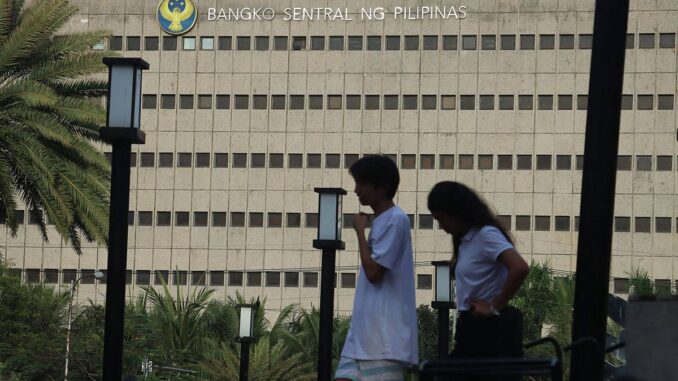
LOWER fuel and food prices coupled with favorable base effects will likely pull inflation down in September, analysts said, raising the possibility of more interest rate cuts by the Bangko Sentral ng Pilipinas (BSP).
The median forecast in The Manila Times poll of economists was 2.6 percent, near the bottom of the central bank’s 2.0- to 4.0-percent target and down from the August result of 3.3 percent.
All but one of the economists expect consumer price growth to slow in September.
The BSP will release its estimate for the month today while official inflation data will be issued by the Philippine Statistics Authority this Friday.
Metrobank Research had the lowest projection of 2.3 percent, which it said would be due to a continued slowdown in rice inflation and lower oil prices.
“The forecasted inflation rate, if realized, would provide a more favorable economic environment, suggesting that government efforts to manage rice prices and global oil price trends are having a positive impact,” it added.
“This also provides more space for the central bank to deliver two more 25-basis-point cuts each at the remaining Monetary Board meetings this year to help economic growth as inflation slows.”
The BSP’s policymaking Monetary Board last month kicked off an easing cycle by ordering a 25-basis-point cut, which brought the benchmark rate down to 6.25 percent.
BSP Governor Eli Remolona Jr. last week said that two additional rate cuts were likely given an improving inflation outlook.
Pantheon Macroeconomics economist Miguel Chanco, meanwhile, expects September inflation to drop to 2.4 percent due to “still-high and favorable base effects from last year’s rice-price spike.”
“The rate of transport price deflation should deepen, in view of the ongoing decline in fuel prices,” he added.
“The risks, I’d say, are probably tilted to the downside, given that we’ve yet to see the cut in rice tariffs filter fully through to the CPI (consumer price index) numbers,” he added.
Malacañang in June slashed the tariff on rice imports to 15 percent from 35 percent in an effort to keep a lid on inflation. Surging prices of the staple had led to a spike in consumer prices earlier this year.
For HSBC Global Research economist Aris Dacanay and Security Bank Corporation chief economist Robert Dan Roces, inflation will likely drop to 2.5 percent this month.
Dacanay said that fuel prices had fallen by up to 7.0 percent month-on-month, driven by lower global oil prices and a stronger peso.
If inflation settles at 2.5 percent year-on-year, he added, the likelihood of an October policy rate cut by the central bank could increase.
Roces, meanwhile, said that slower food prices would lead to lower inflation, but noted that “potential risks from oil and typhoons may keep the BSP cautious about interest rate cuts.”
“The central bank is likely to opt for a gradual approach, with 25-basis point reductions in October and December,” he said.
Rizal Commercial Banking Corp. chief economist Michael Ricafort, for his part, said base effects would lead to 2.6 percent inflation for September.
The decline, he added, will continue due to the lower tariffs on imported rice and reduced world prices.
Union Bank of the Philippines chief economist Ruben Carlo Asuncion and Philippine National Bank economist Alvin Arogo, meanwhile, said that consumer price growth could slow to 2.8 percent in September.
“Disinflation may come largely from broad food and transport CPI,” Asuncion said.
“Particularly, we expect declines from rice prices and lower gasoline/diesel prices from declining global prices,” he added.
“The continuation of faster disinflation in September further validates an October BSP rate cut of 25 bps,” Asuncion continued.
Arogo said that August’s steady consumer price index for food and nonalcoholic beverages offered a buffer against the potential negative effects of current and upcoming typhoons on overall food prices.
“Moreover, the combination of Executive Order 62 (lower rice tariff), downtrend in key imported commodities (e.g., Vietnam rice and Dubai crude), and favorable base effects should result in average inflation of 3.0 percent from September to December,” he added.
ING Manila Bank Asia-Pacific Regional Head of Research Robert Carnell also expects inflation to ease, to 2.9 percent, on the back of small decline in “rice prices in and lower transport fuel prices will have been offset by increases in fruit and vegetables and some other prices.”
“That should provide Bankgo Sentral ng Pilipinas with an excuse for another 25bp of rate cuts at its next meeting on 17 October,” he said.
Emmanuel Lopez from the University of Sto. Tomas Graduate School was the only one among the analysts polled to forecast an uptick in September inflation to 3.4 percent.
He said that a combination of factors, including rising electricity rates and fluctuating prices of agricultural goods and basic petroleum products, could push inflation slightly above the August result.


Be the first to comment